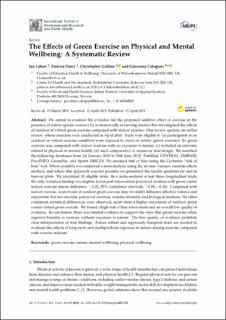The Effects of Green Exercise on Physical and Mental Wellbeing: A Systematic Review
Peer reviewed, Journal article
Published version
Permanent lenke
https://hdl.handle.net/11250/2648596Utgivelsesdato
2019Metadata
Vis full innførselSamlinger
Originalversjon
10.3390/ijerph16081352Sammendrag
We aimed to examine the evidence for the proposed additive effect of exercise in the presence of nature (green exercise) by systematically reviewing studies that investigated the effects of outdoor or virtual green exercise compared with indoor exercise. Our review updates an earlier review, whose searches were conducted in April 2010. Trials were eligible if: (a) participants in an outdoor or virtual exercise condition were exposed to views of nature (green exercise); (b) green exercise was compared with indoor exercise with no exposure to nature; (c) included an outcome related to physical or mental health; (d) used comparative or crossover trial design. We searched the following databases from 1st January 2010 to 28th June 2018: PubMed, CENTRAL, EMBASE, PsycINFO, GreenFile, and Sports DISCUS. We assessed risk of bias using the Cochrane “risk of bias” tool. Where possible we conducted a meta-analysis using the inverse variance random-effects method, and where this approach was not possible we presented the results qualitatively and in harvest plots. We identified 28 eligible trials. In a meta-analysis of just three longitudinal trials, the only statistical finding was slightly lower post-intervention perceived exertion with green versus indoor exercise (mean difference: −1.02; 95% confidence intervals: −1.88, −0.16). Compared with indoor exercise, acute bouts of outdoor green exercise may favorably influence affective valence and enjoyment, but not emotion, perceived exertion, exercise intensity, and biological markers. No other consistent statistical differences were observed, apart from a higher enjoyment of outdoor green versus virtual green exercise. We found a high risk of bias across trials and an overall low quality of evidence. In conclusion, there was limited evidence to support the view that green exercise offers superior benefits to exercise without exposure to nature. The low quality of evidence prohibits clear interpretation of trial findings. Future robust and rigorously designed trials are needed to evaluate the effects of long-term and multiple-bout exposure to nature during exercise compared with exercise indoors.
